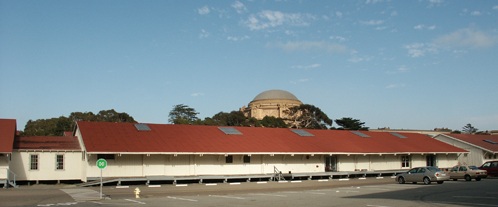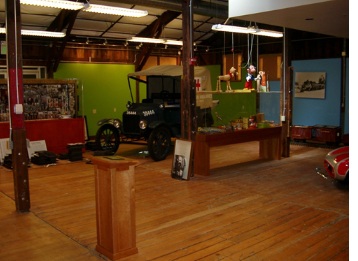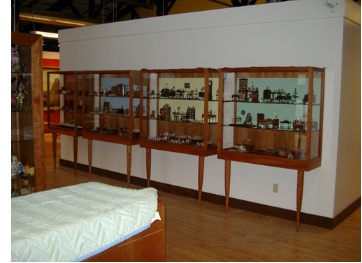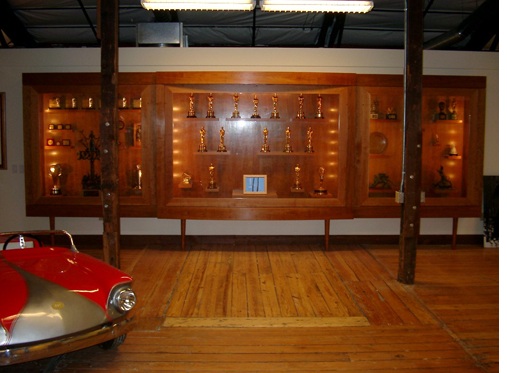In recognition of The Walt Disney Family Museum's anniversary, we'd like to look back and share stories of the time, work, and energy that went into building the museum. In the first of this series, we remember the museum's roots and first home at Gorgas. This article, penned by the Walt Disney Family Foundation's director of collections Michael Labrie, was originally written and posted for the museum's first anniversary in 2010.

In 2003, I was brought to a warehouse in the Presidio of San Francisco to view a collection of memorabilia and artifacts for a museum that was being designed and planned for this location.
To this day and for the rest of my life, I will never forget my first visit -- walking through the double doors and seeing Walt Disney’s 1/8 scale steam locomotive, the Lilly Belle, as well as cases filled with miniatures, and a wall full of Academy Awards!
The wooden structure was built in 1918 to store medical supplies and equipment used at the nearby Letterman Army Hospital. After the hospital was demolished, the new Letterman Digital Arts Center was constructed to be the combined home of Industrial Light & Magic, LucasArts, and Lucasfilm's marketing. This is right down the street from our little warehouse!
Considering this building was a tinderbox filled with treasures, at the time, it wasn’t so obvious that this was the new hub of animation in the Bay Area!
 In the very beginning, the Walt Disney Family Museum was established as a ”virtual” museum online, with Disney historians, Richard and Katherine Greene, working as “curators ” of exhibits. Plans of a brick and mortar museum were being developed for an attractive low-key operation where school groups and Disney fans might view this modest collection of awards, citations, and artwork collected by, and attributed to, Walt Disney.
In the very beginning, the Walt Disney Family Museum was established as a ”virtual” museum online, with Disney historians, Richard and Katherine Greene, working as “curators ” of exhibits. Plans of a brick and mortar museum were being developed for an attractive low-key operation where school groups and Disney fans might view this modest collection of awards, citations, and artwork collected by, and attributed to, Walt Disney.
In the collection were Walt’s train, a WWI Ford Model T ambulance similar to the one that he drove in France, his collection of miniatures, as well as a bright red Autopia car from Disneyland. But this modest warehouse was not suited for the groups that would visit, nor was it adequate to house a collection of this importance. Guided by the vision, dedication and passion of Diane Disney Miller and her family, we knew we had to do more. That path lead us to the state-of-the-art building we are now occupying at 104 Montgomery Street.
 In 2004 a large portion of the collection was still in boxes, crates, and files in need of proper storage, and documentation of their current condition. As we made progress, storage cabinets were specified and planning for staff was underway. My team for collections management began with a consultant, Paloma Añoveros, an Art Conservator, Martín Salazar, and two Registrar interns, Lynne Philips and Karen Hong, who were completing their masters at the JFK Institute for Museum Studies. It was a daunting task to start from square one, but we all forged ahead.
In 2004 a large portion of the collection was still in boxes, crates, and files in need of proper storage, and documentation of their current condition. As we made progress, storage cabinets were specified and planning for staff was underway. My team for collections management began with a consultant, Paloma Añoveros, an Art Conservator, Martín Salazar, and two Registrar interns, Lynne Philips and Karen Hong, who were completing their masters at the JFK Institute for Museum Studies. It was a daunting task to start from square one, but we all forged ahead.
Martín began evaluating and preserving the collections for storage, study, and exhibition. He was instrumental in establishing our standard for digitally documenting the artifacts and creating a wonderful way to exhibit works on paper (which you will see in the galleries).
Anel Muller was hired as the Museum Registrar. With Anel came the birth of a new database, a data dictionary, and comprehensive registration planning. Two new assistant registrars were hired, Mark Gibson and Rachael Zink. In addition to making great progress with the collections, Anel gave birth to her first child, Laila. Upon her return from maternity leave, we had a librarian intern, Phil Chiu, who made a large contribution of his time and efforts. Bob Mosley joined the team and supported our immediate IT needs, and planned for the future needs of the institution.
 Moving forward, Diane Disney Miller was excited to see we were functioning as a museum! We were dealing with loans to other institutions, cataloguing old and new acquisitions, as well as making the collections available to an onslaught of designers, consultants, contractors, and architects, with back-to-back meetings all for planning the new facilities.
Moving forward, Diane Disney Miller was excited to see we were functioning as a museum! We were dealing with loans to other institutions, cataloguing old and new acquisitions, as well as making the collections available to an onslaught of designers, consultants, contractors, and architects, with back-to-back meetings all for planning the new facilities.
Many new faces joined our team in preparation for the move. Our conservator, Martín managed an intern, Harvey Newman, who created custom boxes for the artifacts. Joined by Issey Honton, with enthusiasm and innate skills, these two young men, worked closely with Martín preparing the artworks on paper for the future exhibitions. Anel and Rachael spearheaded the move, (which you will read about as part of this anniversary series) and Mark Gibson made progress photographing the new acquisitions before becoming Digital Assets Coordinator. Everyone on the team was honing their skills, working hard to get the job done.
Considering the condition, rarity and fragility of the artifacts, and the need for the designers to “get their hands on” the pieces to design the museum cases, we created facsimiles of all the objects for them to use in the design process. It was an effective, productive, and safe way to do the layouts.
As part of this anniversary series, you will find out about the monumental move of all the collections as they traveled from the Gorgas warehouse to our new facilities. You will also learn about the mount-making for all the artifacts on exhibition in our galleries.
All of this preparation and dedication from my team of professionals helped to achieve the goal of bringing the collections of the Walt Disney Family Foundation to the world!
—Michael Labrie, Director of Collections for The Walt Disney Familiy Museum and Walt Disney Family Foundation
Building photos courtesy of the Bruce Gordon collection at the WDFM.
